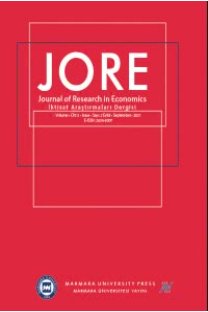KEY SECTOR ANALYSIS FOR TURKEY: MODIFICATION OF RASMUSSEN MEASURES
This paper investigates key sectors of Turkish Economy by using the key sector classification proposed by Hewings (1974). The paper proposes a new measure based on Rasmussen’s forward linkage measure “sensitivity of dispersion index”. The measures given by Rasmussen are based on Leontief inverse matrix, which is demand driven. The paper translates Rasmussen’s forward linkage measure to supply-driven models by using Ghosh inverse matrix. Application part calculates backward and forward linkages of Turkey by using 2012 Input-Output table which is released by TURKSTAT (2020) and classifies key sectors of Turkish Economy by comparing new and old measures.
Keywords:
Input-output Matrix, Key Sectors, Power of Dispersion Index, Sensitivity of Dispersion Index, Coefficient of Variation, Ghosh Inverse Leontief Inverse,
___
- Akbulut, H. (2019). Türkiye’de İmalat Sanayi Sektörünün Ekonomik Etkileri: Girdi-Çıktı Modeli Analizi. Sosyoekonomi, Vol. 27(42), 241-253.
- Aydoğuş, O. (1999). Girdi-Çıktı Modellerine Giriş, Teori ve Uygulama. Ankara: Ankara Kitapevi.
- Bayers, W. B. (1976). Empirical identification of key sectors: some further evidence. Environment and Planning A, volume 8, 231 – 236.
- Chenery, H. B., & Watanabe, T. (1958, October). International Comparisons of the Structure of Production.Econometrica, Vol. 26, No. 4, 487-521.
- Dhawan, S., & Saxena, K. K. (1992). Sectoral Linkages and Key Sectors of the Indian Economy. Indian Economic Review, New Series, Vol. 27, No. 2, 195-210.
- Doğruel, A., & Doğruel, F. (2018). Türkiye’de Yapısal ve Teknolojik Değişme. In N. Engin, E. Aslanoğlu, O.Erdoğan, B. C. Karahasan, & K. Tata, Taner Berksoy’a Armağan: Türkiye Ekonomisinde Kalkınma ve Dönüşüm (pp. 267-286). İstanbul: İmge Publications.
- Eurostat. (2008). Nace Rev. 2, Statistical classification of economic activities in the European Community. Luxemburg: European Comission.
- Ghosh, A. (1958). Input-Output Approach in an Allocation System. Economica, New Series, Vol. 25, No. 97, 58-64.
- Hazari, B. R. (1970). Empirical Identification of Key Sectors in the Indian Economy. The Review of Economics and Statistics, Vol. 52, No.3, 301-305.
- Hewings, G. J. (1974). The effect of aggregation on the empirical identification of key sectors in a regional economy: a partial evaluation of alternative techniques. Environment and Planning A, volume 6, 439-453.
- Hirschman, A. 0. (1958). The Strategy of Economic Development. New Haven: Yale University Press.
- Jones, L. P. (1976). The Measurement of Hirschmanian Linkages. The Quarterly Journal of Economics, Vol. 90, No. 2, 323 – 333.
- Kula, M. (2008). Supply – Use and Input-Output Tables, Backward and Forward Linkages of Turkish Economy. The 16th Inforum World Conference, (pp. 1-20). Northern Cyprus.
- Miller, R. E., & Blair, P. (2009). Input–Output Analysis, Foundations and Extensions. New York: Cambridge University Press,.
- Pehlivanoğlu, F., & İnce, M. R. (2020). Girdi-Çıktı Analizi Yaklaşımıyla Türkiye Ekonomisinde Sektörlerarası Bağınlaşmanın Uzun Dönemli Analizi. Sosyoekonomi, Vol. 28(44), 169-190.
- TURKSTAT. (2020, May 02). Girdi-Çıktı Tabloları. Retrieved from Turkstat: http://www.tuik.gov.tr/ PreTablo.do?alt_id=1021
- Yay, G. G., & Keçeli, S. (2009). The Intersectoral Linkage Effects in Turkish Economy: An Application of Static Leontief Model. Panoeconomicus, issue 3, 301-326.
- Yotopoulos, P. A., & Nugent, J. B. (1973). “A Balanced-Growth Version of the Linkage Hypothesis: A Test”. The Quarterly Journal of Economics, Vol. 87, No. 2, pp. 157-171.
- ISSN: 2636-8307
- Başlangıç: 2016
- Yayıncı: Marmara Üniversitesi
Sayıdaki Diğer Makaleler
COMPARATIVE ANALYSIS OF PRODUCTION EFFICIENCY IN WEST AFRICA
Alexandrov N. S. SEMANOU, Kamil USLU
TÜRKİYE EKONOMİSİNDE TOPLAM FAKTÖR VERİMLİLİĞİ: 1980-2019
KEY SECTOR ANALYSIS FOR TURKEY: MODIFICATION OF RASMUSSEN MEASURES
Alexandrov N. S. SEMANOU, Kamil USLU
REMITTANCE AND POVERTY IN SOMALIA: PROPENSITY SCORE MATCHING APPROACH
